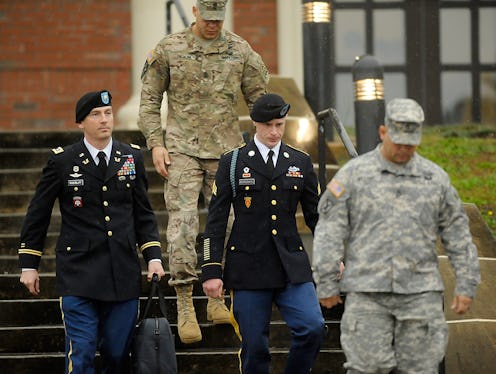News
Bergdahl, After His First Escape Attempt — PHOTO
A viral tweet that eventually became fodder for masses of Americans looking to take apart Bowe Bergdahl's story of Taliban captivity may have had a much darker back story than previously understood. On Thursday, during season two, episode three of Serial, the Army sergeant and former prisoner of war described an escape attempt that went awry, ending with days of painful punishment and a now-famous photo which showed Bergdahl smiling and posing with one of his captors. At the time, Bergdahl's critics alleged that the photo was further proof he was a Taliban sympathizer. For his part, Bergdahl claimed that was patently untrue.
Although Bergdahl had fled his captors before, the majority of his previous attempts had been haphazard incidents that were brought to a halt within minutes of escape. During one of his first attempts, Bergdahl told filmmaker Mark Boal and Serial host Sarah Koenig that there had been no real plan — in one instance, he said he had managed to slip his wrists out of his chains and had shimmied the wire across the door free before taking off running. Minutes later, he was captured on the rooftop of a nearby house, where he had been attempting to hide.
By the end of Bergdahl's first year in captivity however, his strategy had changed. After slowly amassing a collection of small items (which he turned into tools as part of an "escape kit"), Bergdahl fell upon a stroke of luck when one of his Taliban captors accidentally dropped a key that opened a separate lock somewhere in the building, which he called "the mountain fortress" due to its daunting size and high towers
Although the key didn't match the "cheap" padlocks on the chains around his ankles as he described them, Bergdahl later recounted that with enough time and maneuvering, he was able to get the mismatched key to pop open the locks anyway.
"With that one key ... it allowed me to open the three padlocks [holding together] the chains around my feet and the chains ... by the door," Bergdahl told Boal and Koenig.
A few months after he stumbled upon the key, Bergdahl said he was finally able to devise a plausible escape from his second-story room in the mountain fortress, which had a sizable window and no bars across it. Compounding the fortuitous situation was the fact that his guards seemed to have relatively forgotten he was even there. "He seemed so pathetic by that point ... his guards weren't taking extra precautions," Koenig said during Thursday's episode, quoting Bergdahl.
With his collection of items— which included a nail, a piece of PVC pipe, an empty Mountain Dew container, and some scattered items of clothing — on hand, Koenig said he "went for it."
"In the middle of the night, I put everything together—I had practiced [this] before—and started counting the hours down until I knew everyone was asleep for the most part," Bergdahl recalled. "[After tying together bed sheets and chains] I threw the makeshift rope out the window ... and climbed out."
Despite a successful initial escape, Bergdahl's fortune wouldn't last. Nine days after fleeing the mountain fortress, hiding from villagers and maneuvering over jagged terrain, he stepped off a cliff while attempting to find a way around a sheep herder's tent, (breaking his ankle?)
"The initial drop, [I thought] 'Oh, good grief', but then I kept falling," Bergdahl recalled in his interview with Boal, adding that the noise attracted the attention of a few dogs nearby. "Maybe about 30, 40 feet from where I had fallen, there was a creek, so I wanted to [replenish my water supply] ... but when I pulled the water bottle out, that was when I realized that I couldn't actually move my fingers. That was my first inkling that [my injuries] were a lot worse than I was feeling at the time."
Bergdahl had injured both his leg and arm on his first night of freedom, a detriment that would later lead to his recapture, given that he was often laid up, crouched in the bush and hiding from passing villagers. Some nine days later, Bergdahl was found by a Taliban search party, taken back to the mountain fortress, and beaten. "If you try to escape again," Bergdahl recalled his captors saying, "we'll just kill you."
Despite the ordeal, Bergdahl did try to escape an additional 11 times over the next five years, which made the photo his captors snapped of him shortly after his first major attempt all the more insulting. In the photograph, which was initially tweeted from an account associated with the Taliban nine days after Bergdahl's rescue in 2014 and circulated heavily by Bergdahl's detractors, Bergdahl could be seen smiling, the arm of one Taliban commander draped around his shoulders.
A second tweet included the caption,
Bowe #Bergdahl was really impressed when he saw the hospitality of #Taliban He first thought that he will be tortured But he was wrong
The Pentagon later called the image "100 percent propaganda", but the damage had already been done. For many in the public sphere, Bergdahl was seen as a traitor.
That sort of vicious battle of words, something of a "he said/he said" between Bergdahl and the Taliban, has now reared its head once more, with Bergdahl's court martial and impending legal battle. Of course, the weekly Serial episodes could help change that. Because if Bergdahl's interview with the podcast has proven anything, it's that a picture might indeed speak a thousand words — but those words might not always be the truth.
